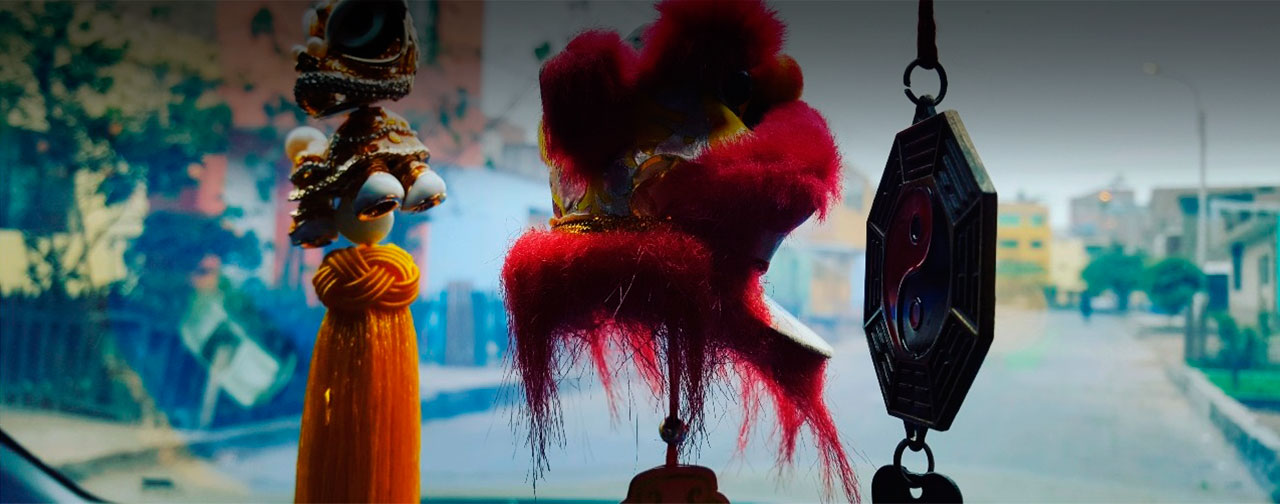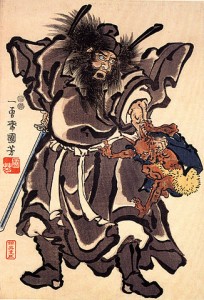[EN/ES] Hungry Ghost Festival and the cross-cultural nature of roots
- [EN/ES] Today in Chinese History (28 August 2014): Shakespeare and the Taichang Emperor - 28 agosto, 2019
- [EN/ES/CH] Guiping, Guangxi: The Taiping Rebellion - 19 marzo, 2019
- [EN/ES/CH] Guangzhou, Guangdong: Foreign trade - 25 febrero, 2019
(originally published in http://www.mychinaroots.com/portfolio-items/hungry-ghost-festival-and-the-cross-cultural-nature-of-roots/
[English]
Ghosts come in all shapes and sizes, especially Chinese ones. There are water ghosts, headless ghosts, friendly old lady-ghosts, and, as pictured here, hungry ghosts.
Like all hungry ghosts, you can recognize him by his needle-thin neck, which hardly allows any food to pass through, and by his stomach, big and empty as a balloon. Whereas most of his demon friends in the lower realm did evil things during their lives, the pictured, unlucky devil became a hungry ghost simply because his descendants neglected him after his death.
However, during this year’s month of August, our hungry ghost has less to complain about. It is “Ghost Month” and if you have ever been in the underworld, you will know that that is when the gates of hell open up. For a whole month, our pictured hungry ghost is free to spend time on earth, reminisce at nostalgic places, and eat, swim, roam at leisure.
Moreover, since his descendants are burning incense and paper money for him again, he visits them on Ghost Day (the 15th lunar day of the Ghost Month). On this evening, he attends a delicious meal in the house of his descendants, who have set a chair at the dinner table especially for him. After dinner, he may meet up with some underworld friends to catch a live theater performance, where slightly nervous humans have kept the front rows of seats empty for hungry ghosts.
The roots of Ghost Day
Our hungry ghost’s night out was made possible by a monk some 2600 years ago. He was a Buddhist monk with supernatural powers, who wanted to trace his deceased, beloved mother.
Imagine the shock on his face when he found her in one of the lower realms as a hungry ghost, complete with needle neck and bloated belly! Apparently, during her lifetime, his mother had spent all the money he had given her to provide for visiting Buddhist monks on her own pleasures. While disappointed with her actions, the monk begged his master for help in getting his mother out of the underworld.
Fortunately for the monk, his master was Gautama Buddha himself. First, Buddha taught the monk to properly feed hungry ghosts; this allowed for the monk’s mother to be reborn as the dog of a noble family. Then, Buddha instructed the monk to offer food and robes to 500 other monks, a good deed of such proportions that it merited a human birth for his mother. The day of offering became known as Ghost Day.
Zhong Kui, the ugly “demon crusher”
But not all is fun and games for hungry ghosts on Ghost Day: woe unto the unsuspecting hungry ghost that runs into Zhong Kui, a demons’ worst nightmare.
When Zhong Kui was born at the start of the Tang Dynasty (618-907AD), it was clear that the boy was special. However, while he turned out to be brilliant and supremely talented, he was unfortunately also supremely ugly. He had hideous, ring-like eyes and a square, misshaped, black face. Although Zhong achieved the very highest honors in the famously difficult imperial examinations, he was rejected as a government official for being too ugly. Out of anger, Zhong Kui smashed his head violently into the palace gates until he cracked his skull and died.
Some years later, Tang Dynasty Emperor Xuanzong (see our previous story about Qingming) had a dream while being gravely ill. In the dream, a large, powerful, ugly ghost saw a small ghost stealing a purse and a flute. Righteous and ruthless, the large ghost captured the smaller ghost, tore out his eye, ate it, and then introduced himself to the Emperor as Zhong Kui the “Demon Crusher.” When the Emperor awoke, he had recovered from his illness. Regarding it as an omen, he introduced Zhong Kui as popular mythical hero, fighting demons and hungry ghosts across the world and through the ages.
What’s in a root?
The above stories are the roots of the Chinese Hungry Ghost festival, celebrated predominantly by Chinese on the Mainland, Hong Kong and Taiwan, and in Singapore and Malaysia.
But how Chinese is the festival and what are the roots behind the stories? The festival’s key origins are in India, where the monk lived and where Buddhism started. Belief in a continuous cycle of rebirth came from India too, while belief in a spiritual world for immortals and deities was influenced by Taoism, and ancestral worshipping by Confucianism. Combining that with the historical Xuanzong Emperor and mythological Zhong Kui, it is safe to say that the Hungry Ghost Festival is a big soup of sources and origins.
Also interesting is that there are numerous cross-cultural versions of hungry ghosts across the globe. Japanese hungry ghosts are cursed to eat excrement or human corpses. Hungry Hindu ghosts are obsessed with the things that made them evil while they were alive. Early Jewish and Christian texts talk about Grigori who wander the earth, yearning for food while having no mouths to eat with. Americans welcome spirits during Halloween and place jack o’ lanterns on their porch to ward off the demons in exactly the same way that Chinese hang pictures of Zhong Kui outside their doors.
Our roots are never mono-cultural as no culture exists in complete isolation. Moreover, what may be categorized as “one culture” in turn consists of a variety of sub-cultures, each with their own beliefs and customs. Learning about our roots does not just teach us about ourselves and those that we take to be similar to us; learning about our roots also teaches us how similar we are to those that we take to be different. All our cultures share essential commonalities as all are created by humans (and maybe a handful of hungry ghosts).
[Español]
Los fantasmas vienen en todas las formas y tamaños, especialmente los fantasmas chinos. Hay fantasmas de agua, fantasmas sin cabeza, fantasmas ancianos y, tal como se ve en la foto, fantasmas hambrientos.
Se puede reconocer con facilidad a los fantasmas hambrientos por su cuello delgado y fino como una aguja -que apenas permite que pase comida- y por su estómago grande y vacío como un globo. Mientras que la mayoría de sus amigos demonios del reino inferior hicieron cosas malas durante sus vidas, este desafortunado demonio solamente se convirtió en un fantasma hambriento porque sus descendientes lo descuidaron después de su muerte.
Sin embargo, cada año durante el mes de agosto el fantasma hambriento tiene menos de qué quejarse. Es el “mes de los fantasmas” y, si alguna vez has estado en el inframundo, sabrás que es cuando las puertas del infierno se abren. Durante un mes entero, el fantasma hambriento es libre de pasar tiempo en la tierra, recordar lugares nostálgicos, comer, nadar y vagar libremente.
Gracias a que sus descendientes queman incienso y papel moneda, él los visita en “el día de los fantasmas” (el décimo quinto día lunar del “mes de los fantasmas”). Esa noche, él asiste a una deliciosa cena en la casa de sus descendientes, quienes han dispuesto una silla alrededor de la mesa especialmente para él. Después de la cena se suele encontrar con algunos amigos del inframundo para asistir a un espectáculo teatral en vivo en el que los seres humanos, con un miedo prudente, han reservado las primeras filas de asientos vacías para los fantasmas hambrientos.
Las raíces de “el día de los fantasmas”
La noche del fantasma hambriento es posible gracias a un monje de hace unos 2600 años. Era un monje budista con poderes sobrenaturales que quería rastrear a su amada y difunta madre.
¡Imagínese la impresión de su rostro cuando la encontró en uno de los reinos inferiores como un fantasma hambriento, con el cuello de aguja y el vientre hinchado! Al parecer, la madre había gastado durante su vida todo el dinero que el hijo le había dado en satisfacer sus propios placeres visitando monjes budistas. Aunque estaba decepcionado con las acciones de su madre, el monje le pidió ayuda a su maestro para sacar a su madre del inframundo.
Para fortuna del monje, su maestro era el mismísimo Buda Gautama. Primero, Buda le enseñó al monje a alimentar adecuadamente a los fantasmas hambrientos. Esto permitió que la madre del monje renaciera como el perro de una familia noble. Luego, Buda instruyó al monje para que ofreciera comida y vestido a otros 500 monjes; una acción noble de tales proporciones permitiría un nacimiento humano para su madre. Así, el día de la ofrenda se conoció como “el día de los fantasmas”.
Zhong Kui, el horrendo “triturador de demonios”
Pero no todo es diversión y juego para los fantasmas hambrientos en “el día de los fantasmas”: ay del fantasma hambriento que, desprevenidamente, corra hacia Zhong Kui, la peor pesadilla de los demonios.
Cuando Zhong Kui nació, al comienzo de la dinastía Tang (618-907AD), estuvo claro que era especial. Desafortunadamente, aunque resultó brillante y supremamente talentoso, era supremamente feo también. Tenía unos ojos horribles y anulares, y un rostro negro, cuadrado y deforme. Aunque Zhong logró los honores más altos en los famosos exámenes imperiales, fue rechazado como funcionario del gobierno por su extrema fealdad. Cegado por la ira, Zhong Kui estrelló violentamente su cabeza contra las puertas del palacio hasta agrietarse el cráneo y morir.
Algunos años más tarde, el emperador de la dinastía Tang, Xuanzong (ver la historia anterior sobre Qingming), tuvo un sueño mientras estaba gravemente enfermo. En el sueño, un fantasma grande, poderoso y feo veía a otro, más pequeño, robar un bolso y una flauta. El gran fantasma, justo y despiadado, capturó al fantasma más pequeño, le arrancó el ojo, se lo comió y luego se presentó ante el emperador como Zhong Kui el “triturador de demonios.” Cuando el emperador despertó se había recuperado de su enfermedad. Considerándolo un presagio, introdujo a Zhong Kui como un mítico héroe popular que luchaba contra demonios y fantasmas hambrientos a través del mundo y en todas las épocas.
¿Qué hay en una raíz?
Las anteriores historias son las que dieron origen al festival chino del fantasma hambriento, celebrado principalmente por los chinos de la zona continental, de Hong Kong y de Taiwán, además de los de Singapur y Malasia.
Pero, ¿cómo es este festival chino y cuáles son las fuentes detrás de estas historias? Los orígenes clave del festival están en la India, donde vivió el monje y donde comenzó el budismo. La creencia en un ciclo continuo de renacimiento también provino de la India mientras que la creencia en un mundo espiritual para inmortales y deidades fue influencia del taoísmo. Asimismo, la adoración ancestral viene del confucianismo. Todo esto combinado con el histórico emperador Xuanzong y el mitológico Zhong Kui. De este modo, se puede afirmar que el festival de los fantasmas hambrientos tiene una gran mezcla de orígenes y fuentes.
También es interesante comprobar las numerosas versiones de fantasmas hambrientos en diferentes culturas de todo el mundo. Los fantasmas hambrientos japoneses están maldecidos por comer excrementos o cadáveres humanos. Los fantasmas hambrientos hindúes están obsesionados con las cosas que los volvieron malvados cuando estaban vivos. Los primeros textos judíos y cristianos hablan de los grigori, que vagan por la tierra anhelando comida pese a no tener boca para comer. Los estadounidenses reciben a espíritus durante Halloween y colocan “linternas de Jack” en su pórtico para protegerse de los demonios, de la misma manera en que los chinos cuelgan imágenes de Zhong Kui fuera de sus puertas.
Nuestras raíces nunca son monoculturales, puesto que ninguna cultura existe en completo aislamiento. Por otro lado, lo que puede ser categorizado como “una cultura” consiste a su vez en una variedad de subculturas, cada una con sus propias creencias y costumbres. Aprender acerca de nuestras raíces no sólo nos enseña sobre nosotros mismos y los que consideramos similares a nosotros. También nos enseña lo similares que somos a aquellos que tomamos por diferentes. Todas nuestras culturas comparten puntos comunes porque todas son creadas por seres humanos (y tal vez por algún fantasma hambriento).



No hay comentarios